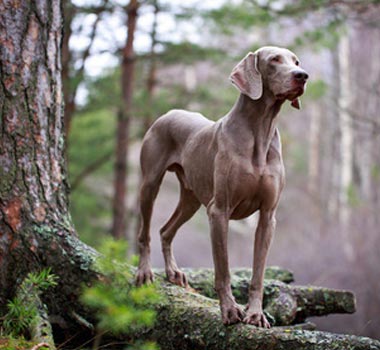 Fascinating beauty with special requirements. Probably no other breed has more potential to become a fashion dog: just the sight of a Weimaraner with its shiny silver coat, supple movements, proud posture and noble, distant facial expression makes many a heart melt. It’s no surprise that more and more people want one of these graceful animals at their side. Unfortunately, the beautiful Weimaraner is only very suitable as a family dog to a limited extent.
Fascinating beauty with special requirements. Probably no other breed has more potential to become a fashion dog: just the sight of a Weimaraner with its shiny silver coat, supple movements, proud posture and noble, distant facial expression makes many a heart melt. It’s no surprise that more and more people want one of these graceful animals at their side. Unfortunately, the beautiful Weimaraner is only very suitable as a family dog to a limited extent.
Brief history of the breed
The Weimaraner was first bred as a separate breed when the Grand Duke of Weimar, Karl August, carried away by their uncompromising drive to hunt, began to specifically breed the pointers. In 1890 they were finally recognized as a breed and from then on they were hunted almost exclusively for a long time.
Nowadays, in times when dogs are hardly seen as farm animals but rather as members of the family, the Weimaraner is finding a place in the hunting lodge less and less, but is increasingly favored as a family dog. However, this is exactly what is difficult: after centuries of selective breeding according to hunting criteria, the Weimaraner is an ideal hunting companion, but is often hopelessly underchallenged in normal life as a family dog.
Appearance of the Weimaraner
The appearance of the Weimaraner is impressive: its silver-colored fur is so noble that it harmonizes wonderfully with its graceful and powerful figure. With a shoulder height of 60-70 cm and a weight of 25-40 kg depending on the size, it is one of the larger hunting dog breeds and shows the typically elegant posture of the classic pointing dogs.
In addition to the common variant, which has a short, strong coat without any significant undercoat, isolated cross-breeding of herding dogs also resulted in a long-haired type, which is, however, very rare. The only difference that the long-haired Weimaraner has to the short-haired type is its medium-long, silky soft fur.
Character characteristics of the Weimaraner
By being bred as a working dog for hunting purposes, the Weimaraner is one thing above all else: willing to work. He has a very strong hunting instinct, which can be a problem when kept as a family dog, as he tends to aggressively look for other ways to reduce his instinct when he is not busy. At the same time, it is precisely this strong hunting instinct that makes him such a versatile hunting dog. In terms of temperament, the Weimaraner is a rather quiet companion whose personality is fully developed relatively late. Many of his traits only become apparent after 2-3 years.
The Weimaraner is a very intelligent breed that seeks intellectual activity and enjoys fulfilling tasks. Together with his affectionate nature, this makes him an easy-to-handle dog that, with a little knowledge, can be trained well and willingly. Nevertheless, he needs consistent training and reliable leadership, otherwise he may use his intelligence to take over the leadership of his “pack”.
The Weimaraner’s strong bond with “his” people also has a disadvantage, because he develops a strong protective instinct towards his human pack. This is where the inbred sharpness comes into play: While other dogs often only bark or pinch the arms and legs, a Weimaraner often attacks directly and does not shy away from going for the throat of its “opponent”. The reason for this is that the Weimaraner was not only used for hunting, but also to ward off poachers. The silver hunting dog’s willingness to uncompromisingly attack people is correspondingly high if it believes there is a need to do so. Until a few years ago, Weimaraners that were approved for breeding even had to prove their sharpness in a test.
Enchantingly beautiful but anything but uncomplicated
As in many cases, the Weimaraner’s enchantingly beautiful appearance hides a complicated character that requires expertise and absolute consistency. Anyone who thinks about getting one of these silver-colored dogs as a decorative accessory will quickly be overwhelmed, because, like the Border Collie, the Weimaraner also needs intensive mental work in addition to physical activity. If the dog cannot be used for hunting (as is often the case), mantrailing or tracking work can be used to meet the needs of this breed – i.eHowever, this requires time and commitment.
Due to the high demand for Weimaraners as family dogs, the number of breeders who advertise their (according to their own statements) non-hunting breeding lines is now increasing. That sounds tempting to some people – a beautiful dog with high intelligence and no hunting instinct! Unfortunately, it’s not that simple: Even though the breed is now increasingly bred as a show and family dog, centuries of breeding as a hunting dog cannot be reversed so quickly. While external characteristics can be changed quickly through targeted mating, character traits often remain constant for a surprisingly long time. And characteristics such as sharpness or strong hunting instincts quickly become dangerous problems if leadership is weak.
But of course it must also be said that there are certainly Weimaraners in whom protective instincts and hunting enthusiasm are less pronounced. The fact that the parents have shown no interest in hunting does not mean that their offspring cannot have strong instincts. And two parent animals that have been hunted are not proof of suitability for hunting. However, as an inexperienced person it is often very difficult to recognize these tendencies – especially in young dogs whose character is not yet developed. That’s why the Weimaraner, despite all its advantages, is by no means a simple family dog for everyone.
Image © DragoNika / fotolia.de

Every day we experience the wonders of nature with our dogs. This inspiration is the basis for our lives and our products. In our magazine we share with you our passion for these wonderful animals. Visit our socials and become part of the DOG FIT community.


Leave a Reply